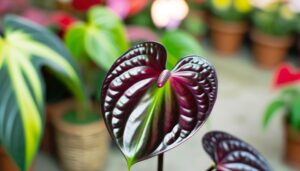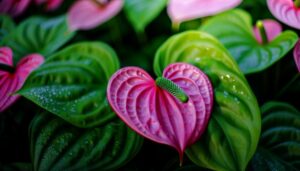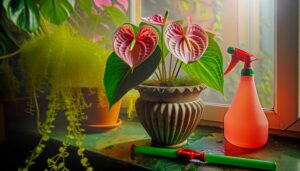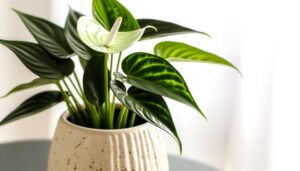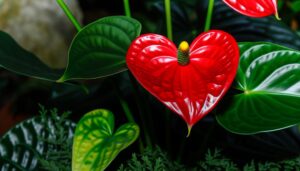Why Are Red Anthurium Leaves Turning Yellow?
Red Anthurium leaves turning yellow can result from improper watering, nutrient deficiencies, lighting issues, pest infestations, and unsuitable soil or humidity levels. Overwatering causes root rot and chlorosis, while underwatering leads to hydric stress.
Nutritional imbalances, particularly in nitrogen, phosphorus, and potassium, interfere with chlorophyll synthesis. Insufficient or excessive light affects photosynthesis and increases oxidative stress.
Pest infestations damage plant tissues and may introduce secondary infections. In addition, poor soil drainage and low humidity levels exacerbate these conditions.
Maintaining ideal care requires precise management of these factors. Explore further to master the complete guide to preventing yellow leaves in Anthuriums.
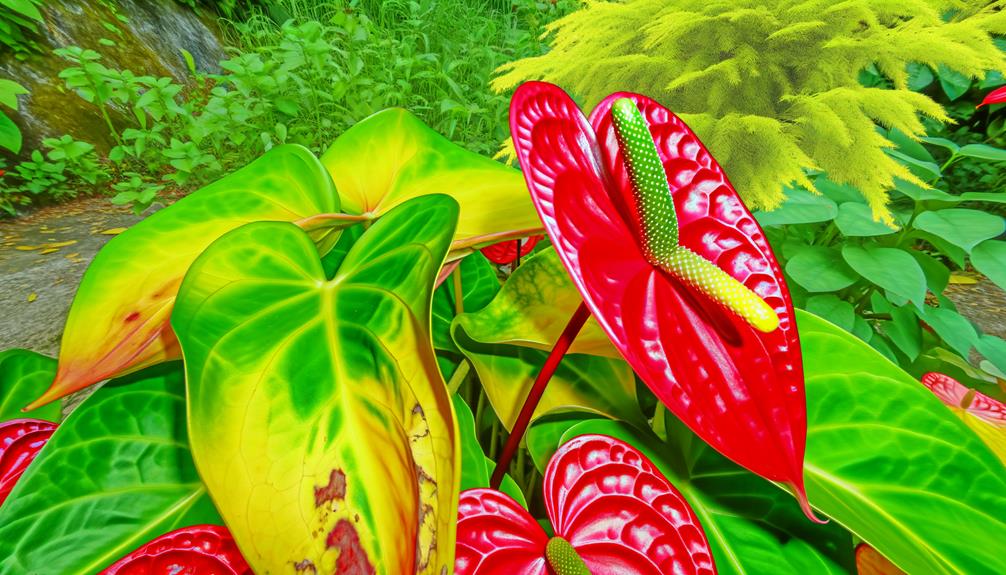
Key Takeaways
- Overwatering leads to root rot and yellowing leaves due to excessive moisture.
- Insufficient watering causes hydric stress, resulting in yellowing leaves.
- Nutrient deficiencies, particularly in nitrogen, phosphorus, and potassium, cause yellowing.
- Inadequate or excessive light exposure impacts chlorophyll synthesis, leading to yellow leaves.
- Pest infestations damage tissues, causing yellowing from direct harm or secondary infections.
Improper Watering
Improper watering, both overwatering and underwatering, is a primary factor contributing to the yellowing of red Anthurium leaves. Excessive water can lead to root rot, a condition caused by anaerobic soil conditions favoring pathogenic fungi. This disrupts root function and nutrient uptake, resulting in chlorosis.
Conversely, insufficient watering induces hydric stress, impairing photosynthesis and causing cellular dehydration. Anthuriums require well-draining soil and a consistent watering schedule to maintain optimal turgor pressure. Soil moisture should be regularly monitored using a moisture meter to prevent extremes.
Additionally, the water quality, particularly its pH and dissolved mineral content, must be considered, as unsuitable water can exacerbate physiological stress. Proper irrigation practices are essential for maintaining the plant's health and vibrancy.
Nutrient Deficiencies
Nutrient deficiencies, particularly involving essential elements such as nitrogen, phosphorus, and potassium, can lead to the yellowing of red Anthurium leaves due to impaired metabolic functions and reduced chlorophyll synthesis. These elements are essential for various physiological processes—nitrogen for amino acid and protein synthesis, phosphorus for energy transfer via ATP, and potassium for enzyme activation and osmoregulation.
| Nutrient | Deficiency Symptoms | Role in Plant |
|---|---|---|
| Nitrogen | Yellowing leaves | Protein synthesis |
| Phosphorus | Stunted growth | Energy transfer |
| Potassium | Leaf edge browning | Enzyme activation |
| Magnesium | Interveinal chlorosis | Chlorophyll production |
| Iron | Leaf yellowing | Chlorophyll synthesis |
Ensuring balanced fertilization and periodic soil testing can mitigate nutrient-related issues, thereby preserving the vibrant hue of red Anthurium leaves.
Lighting Issues
Inadequate or excessive light exposure greatly impacts the health and coloration of red Anthurium leaves, leading to physiological stress and chlorosis. Insufficient light reduces chlorophyll synthesis, causing leaves to yellow due to decreased photosynthetic efficiency.
Conversely, excessive light can cause photoinhibition, damaging chloroplasts and leading to oxidative stress. Best light conditions mimic the plant's native tropical understory habitat, with indirect, filtered sunlight.
Using a light meter to ensure suitable lumens (approximately 10,000-20,000 lux) can mitigate these issues. Additionally, rotating the plant regularly guarantees even light distribution. Understanding the specific photoperiod requirements of Anthurium species is crucial for maintaining foliar vitality, as prolonged exposure to inappropriate light intensities can worsen yellowing and hinder overall growth and development.
Pest Infestations
Pest infestations can severely compromise the health of red Anthurium leaves, often manifesting as yellowing due to direct tissue damage or secondary infections. Common culprits include aphids, spider mites, and mealybugs, which feed on the plant's sap, disrupting nutrient flow and inducing chlorosis.
Aphids excrete honeydew, fostering sooty mold growth that blocks photosynthesis. Spider mites puncture leaf cells, leading to stippling and eventual yellowing. Mealybugs secrete a waxy substance that encourages fungal infections. Early detection through regular inspection is critical.
Utilize integrated pest management (IPM) strategies, combining biological control agents such as predatory insects, and chemical interventions like insecticidal soaps or neem oil, to mitigate these infestations effectively and restore the plant's vigor.
Soil and Humidity
Maintaining the most suitable soil conditions and ambient humidity levels is important for the health of red Anthurium leaves, as these factors directly influence water uptake and nutrient availability.
Anthuriums thrive in well-draining, aerated substrates with pH levels between 5.5 and 6.5. Poorly draining soil can lead to root rot, impairing nutrient absorption and causing chlorosis.
The ideal humidity levels range from 70% to 80%; insufficient humidity can result in transpiration stress, manifesting as yellowing leaves. Conversely, excessive humidity can promote fungal growth.
Utilizing hygrometers for precise humidity monitoring and ensuring adequate airflow can mitigate these issues. Regularly checking and amending soil composition with organic matter and perlite, as well as employing humidifiers, helps maintain an ideal growing environment.
Conclusion
The yellowing of red anthurium leaves serves as a botanical harbinger, signaling underlying distress within the plant's ecosystem.
Improper watering, nutrient deficiencies, inadequate lighting, pest infestations, and suboptimal soil and humidity conditions collectively conspire against the plant's vibrant health.
Each factor, interwoven in a delicate balance, must be carefully monitored and managed to restore the anthurium's verdant vitality.
Addressing these variables with scientific precision guarantees the plant's resilience and flourishing in its cultivated environment.

